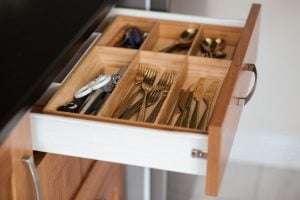Pack your kitchen for a long-distance move
Believe it or not, the kitchen is one of the most difficult things to pack for a move! There are a lot of things to put away, many small items to keep track of, countless breakable things and lots of fragile appliances. And packing gets exponentially harder the farther away you’re moving. So when it’s long distance movers Florida you need, packing your kitchen can be a nightmare. But is there a way to pack your kitchen for a long-distance move without getting a headache? These tips from experienced moving professionals will help you with that!

Tools and appliances you will need to pack your kitchen for a long-distance move
Before you start packing your kitchen for a move, you should gather some supplies first. All the best interstate moving companies Miami agree that you will need the following to pack an average kitchen:
- 5 large boxes
- 10 medium boxes
- 5 heavy-duty boxes
- clear, unprinted wrap paper
- 5 to 10 individual cell kits
- packing tape
- markers and other labels
Pack your kitchen for a long-distance move: a step-by-step guide
The basic principles of packing your kitchen are the same regardless of what you’re packing it for. But when it comes to long-distance moving, you want to take extra care to protect your possessions from damage. That’s the biggest difference between packing for Miami storage facilities and for a long-distance relocation. So prepare to invest in some extra wrapping and packing paper!
Prepare an essentials box first
A box of kitchen essentials seems silly at first glance. But unless you’re planning on eating out in Miami on your first day there, you’re going to need at least some basics ready and easily reachable. A set of cutlery for each member of the family, a couple of plates, a few mugs and an all-purpose pot should tide you over your first few days in the new home.
Start to pack your kitchen for a long-distance move with items you don’t use often
Want to get a head start on packing your kitchen for a long-distance move? Start by packing things you don’t really use much! This includes:
- cookbooks, vases and other decorative items
- unopened bottles of alcohol and wine or beer glasses
- dish towels, washcloths, and tablecloths
- baking supplies (mixing bowls, muffin tins, pie pans and the like)
- special utensils and dishes (barbecue tongs, spatulas, serving plates and fine china for example)
- small appliances such as mixers and blenders
Clear the drawers and shelves next
The next step in packing your kitchen for a long-distance move should be the drawers and the shelves. This is especially important for those items that need to be dismounted or disassembled later. While you’re clearing out your drawers, keep in mind that you don’t need to bring absolutely everything with you. So throw out the things you no longer need to cut down on your kitchen itinerary. Oh, and one more pro tip: pack the messiest drawer first! That way everything else will be easy in comparison.

Pack dishes, pots, and pans next
Dishes, pots, and pans take up the most space in the kitchen. They also take up most of your time when packing the kitchen. This is only in part due to the amount of stuff that falls under the category. In large part, the reason why dishes, pots, and pans are difficult to pack is the fact that they must be individually wrapped and laid safely into boxes. So take your time and use a lot of wrap paper! For especially fragile or valuable items, old cloths and towels may be a good choice for extra protection. If your packing supplies include cell kits, now is the time to use them. Otherwise, try to pack logically in appropriately sized boxes and with lots of cushioning material.
Pack your kitchen for a long-distance move to the end by preparing the appliances for relocation
Finally, finish up with the kitchen by packing your kitchen appliances. Small appliances can be moved in original packaging. If you don’t have it, combine small to medium packing boxes with cushioning material to ensure your appliances arrive in good condition. When it comes to large appliances like stoves and fridges, prepare them for packing at least 24 hours in advance. Shut them down, thoroughly clean them out, and let them air dry for a day or two. That way you will avoid gas and water leaks.
Tips on how to successfully pack your kitchen for a long-distance move
What else can you do to ensure you successfully pack your kitchen for a long-distance move? Here are a few general tips!

Hire someone to pack your kitchen for a long-distance move for you
If you can’t pack your kitchen yourself, hire professional packers to do it for you! Your kitchen will be in safe hands that way. You won’t even have to worry about any packing supplies and you’ll even save yourself a lot of time.
Prepare plenty of packing supplies in advance
You should get all the supplies you need before you start packing. While you’re at it, grab a few extra of everything. That way you won’t have to worry about running out of materials while you’re elbow-deep in cupboard number 3. Instead, you can just focus on packing!
Never pack your kitchen for a long-distance move last
Kitchens are deceptively tidy. This means people often underestimate how much time they need to pack one up. To avoid any delays, never leave your kitchen for last! Make it one of the first rooms you pack instead.
Get an early start!
Another thing that can save you a lot of nerves when you need to pack your kitchen for a long-distance move is starting early. By giving yourself more than enough time to pack your kitchen, you’ll make your relocation easier and less stressful. So what are you waiting for? Go ahead and start packing your kitchen – there’s no time to waste!
